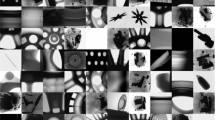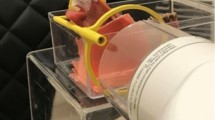Abstract
It is important to reconstruct a continuous surface representation of the point cloud scanned from a human body. In this paper a new implicit surface method is proposed to reconstruct the human body surface from the points based on the combination of radial basis functions (RBFs) and adaptive partition of unity (PoU). The whole 3D domain of the scanned human body is firstly subdivided into a set of overlapping subdomains based on the improved octrees. The smooth local surfaces are then computed in the subdomains based on RBFs. And finally the global human body surface is reconstructed by blending the local surfaces with the adaptive PoU functions. This method is robust for the surface reconstruction of the scanned human body even with large or non-uniform point cloud which has a sharp density variation.
Similar content being viewed by others
References
Douros I, Dekker L, Buxton B F. An improved algorithm for reconstruction of the surface of the human body from 3D scanner data using local B-spline patches [C]//IEEE International Workshop on Modelling People. Washington, DC: IEEE Computer Society, 1999: 29–36.
Hoppe H. Surface reconstruction from unorganized points [D]. Washington: University of Washington, 1994.
Franke R. Scattered data interpolation: Tests of some methods [J]. Mathematics of Computation, 1982, 38(157): 181–200.
Wendland H. Piecewise polynomial,positive definite and compactly supported radial functions of minimal degree [J]. Advances in Computational Mathematics, 1995, 4(1): 389–396.
Morse B S, Yoo T S, Rheingans P, et al. Interpolating implicit surfaces from scattered surface data using compactly supported radial basis functions [C]// Shape Modeling and Applications. Genova: SMI, 2001: 89–98.
Carr J C, Beatson R K, Cherrie J B, et al. Reconstruction and representation of 3D objects with radial basis functions [C]// International Conference on Computer Graphics and Interactive Techniques. New York: ACM, 2001: 67–76.
Wendland H. Fast evaluation of radial basisc functions: Methods based on partition of unity [C]// Chui C K, Schumaker L L, Stöckler J. Approximation Theory X: Wavelets, Splines, and Applications. Nashville: Vanderbilt University Press, 2002: 473–483.
Ohtake Y, Belyaev A, Turk G, et al. Multilevel partition of unity implicits [C]// Fujii J. Modern Techniques for Implicit Modeling. California: ACM, 2005: 463–470.
Pouderoux J, Gonzato J C, Tobor I, et al. Adaptive hierarchical RBF interpolation for creating smooth digital elevation models [C]// Cruz I F, Pfoser D. Data Structures and Computational Geometry. New York: ACM, 2004: 232–240.
Author information
Authors and Affiliations
Corresponding author
Additional information
Foundation item: the National Natural Science Foundation of China (No. 50575139) and the Shanghai Special Fund of Informatization (No. 088)
Rights and permissions
About this article
Cite this article
Lü, Fm., Xi, Jt. & Ma, Dz. Surface reconstruction of scanned human body using radial basis functions and adaptive partition of unity. J. Shanghai Jiaotong Univ. (Sci.) 14, 261–265 (2009). https://doi.org/10.1007/s12204-009-0261-6
Received:
Published:
Issue Date:
DOI: https://doi.org/10.1007/s12204-009-0261-6




